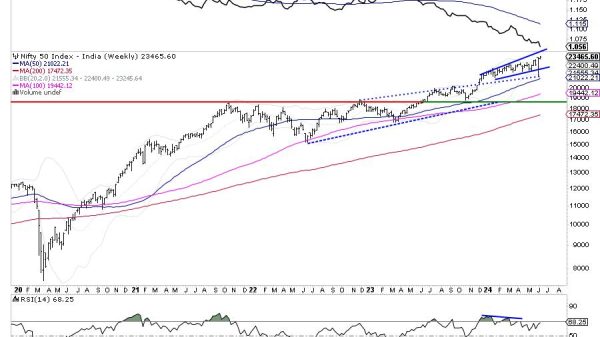
My initial intent was to focus on the number of major equity indices near their all-time highs or attempting to break out of long-term ranges, and how their behaviors around those prior highs over coming months will likely offer significant insight into what comes next. It’s evolved into something else, which I will share with you here.
Making Sense of the Stock Market’s Randomness
I am convinced that most market fluctuations are random, mostly untradable noise. Yet most who work with the financial markets for a living must translate meaningless behavior into a continuous narrative for clients and employers. Importantly, once a narrative is publicly expressed, the analyst/trader becomes entrapped in that narrative, and all the resultant behavioral biases that being identified with a view entails. Working in the institutional setting, my solution was to focus on longer timeframes.
When patterns occur at the proper position on the chart, they become much more valuable and actionable.
Part of the technician’s evolution is finding the style that best suits their emotional and risk management tolerance. For me, it was a long and sometimes painful journey. One of my toughest challenges was finding a systematic approach to separating signal from noise. In other words, when is market behavior important, and when is it not? And if it is, how do I subsequently fashion a trade to take advantage of the informational advantage?
Anyone who has traded for a living knows that market behaviors and patterns are often unreliable. This is particularly true if they are occurring in a trending market and well away from substantive support or resistance (the most obvious exception being early-stage trends and climax/ending structures). Don’t get me wrong; trading-focused systematic entries to established trends can work well. However, I prefer to enter initial positions into trends in their early stages, where I have tighter control over risk management and where my macro opinion, hopefully divergent from the dominant market narrative, is more likely to be a change catalyst.
When patterns occur at the proper position on the chart, they become much more valuable and actionable. To be fair, I don’t ignore day-to-day shifts; staring at tens of thousands of charts for years has given me a decent feel for the short-term fluctuations. However, I place less emphasis on building trading plans or adjusting my positions around them, and I try to avoid labeling them as meaningful for anything more than a short-term trade. In these cases, my chart analysis typically consists of a cursory glance at the price-volume relationships and a general view of the chart. On the other hand, solid confluences of support and resistance that have been well-defined in the weekly and monthly perspectives are my wheelhouse. When I find these markets, I focus on them intently.
In my process, I actively scan for markets, testing well-defined price junctures in their weekly and monthly perspectives. At these junctures, the price/volume behavior combinations in the daily, weekly, and even hourly perspectives become meaningful and often produce actionable insight.
As a professional fixed-income trader, I have always been envious of non-constrained traders who had thousands of global stocks, equity indices, currencies, and commodities across multiple time perspectives to choose from. A fat pitch is always set up somewhere, as long as you are dogged enough to find it.
On To the Charts!
Multiple global equity markets are testing important prior highs, many from monthly perspectives, others from weekly perspectives. These are the situations in which signal quality is high, the price/volume relationships become more important, and where, oftentimes, new trends with quality risk reward tolerances are set up.
These are all charts that have recently moved onto my watch list.
MSCI Italy Capped ETF
The iShares MSCI Italy Capped ETF (EWI) represents a point in case.
CHART 1. Monthly Chart of EWI.
Italy recently moved modestly above the top of a two-decade-long trading range. From this position, even small daily perspective fluctuations generate meaningful information. Importantly, with the long trading range acting as a potential cause, potential breakout targets are much higher, and even a failure back toward the trading range lows would produce roughly a 40–45% return. It’s pretty simple: either the market:
- A) Is breaking out, or
- B) Has washed out the top of the range, sucked in weak hands, and will soon fail back into the range leaving weak hands trapped.
Upon examining the chart, I initially thought it was indeed breaking out of its decade-long trading range.
- The September 2022 low (B) was higher than the prior low (A).
- During the last decline toward the range lows (34.53–20.99) there were significant signs of accumulation.
- The market is clearly above the most immediate horizontal resistance( 34.45–34.53) and just above the 36.88 resistance.
- Corrections since breaking out have mostly taken the form of bull flags or pennants.
However, there are a few caveats.
- Momentum is significantly over-extended in all time frames.
- The weekly slow stochastic is diverging and threatening to roll over.
- The monthly slow stochastic is attempting to roll over.
- EWI is close to the top of the daily, weekly, and monthly Bollinger Bands.
- Multiple price channel tops confluence in the 38.00 area of the chart.
- Volume has declined markedly as the market rallied over the last 19 months. This suggests a lack of selling pressure rather than strong demand.
- Since 2011, the peaks have been running in the mid 40-month range. It’s currently at 35 months.
- While above the most recent resistance, the 2009 high at 43.54 should offer strong resistance.
Suppose the market is ready to pull back. In that case, the price-volume relationships, pattern, behavior relative to support and resistance zone, and other traditional technical relationships should allow early entry into the next meaningful directional move.
For now, I suspect the market may be breaking out in the long term, but the long laundry list of concerns suggests that a pullback is likely to develop before the next strong trending phase begins. The behaviors on the pullback and where the pullback holds (most likely the broken C–D resistance) will be critical (see chart below).
CHART 2. Watch to see if the pullback holds at the C-D resistance in EWI.
The Nikkei 225
The Nikkei is another major market that’s testing its all-time high. The monthly chart below shows the index is at all-time highs and at a channel top. This is clearly a chart to add to my watchlist.
CHART 3. Monthly Chart of the Japan Stock Market Index (JP225).
MSCI India ETF
India is interesting. There has been a very positive change in the reporting on India’s economic outlook, and the market recently moved to a new all-time high. However, note the swell in volume and poor upside result generated by that volume (see monthly chart of iShares MSCI India ETF (INDA) below). I suspect strong hands are selling the rally.
CHART 4. Monthly Chart of iShares MSCI India ETF (INDA). And on a final note, many of the topics and techniques discussed in this post are part of the CMT Association’s Chartered Market Technician’s curriculum.

Disclaimer: Shared content and posted charts are intended to be used for informational and educational purposes only. The CMT Association does not offer, and this information shall not be understood or construed as, financial advice or investment recommendations. The information provided is not a substitute for advice from an investment professional. The CMT Association does not accept liability for any financial loss or damage our audience may incur.





























